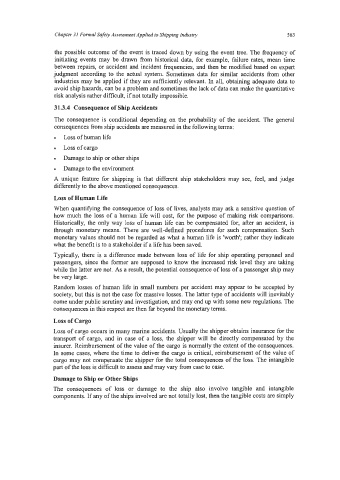Page 587 - Marine Structural Design
P. 587
Chapter 31 Formal Safety Assessment Applied to Shipping Industry 563
the possible outcome of the event is traced down by using the event tree. The frequency of
initiating events may be drawn from historical data, for example, failure rates, mean time
between repairs, or accident and incident fkequencies, and then be modified based on expert
judgment according to the actual system. Sometimes data for similar accidents from other
industries may be applied if they are sufficiently relevant. In all, obtaining adequate data to
avoid ship hazards, can be a problem and sometimes the lack of data can make the quantitative
risk analysis rather difficult, if not totally impossible.
31.3.4 Consequence of Ship Accidents
The consequence is conditional depending on the probability of the accident. The general
consequences from ship accidents are measured in the following terms:
Loss of human life
Lossofcargo
Damage to ship or other ships
Damage to the environment
A unique feature for shipping is that different ship stakeholders may see, feel, and judge
differently to the above mentioned consequences.
Loss of Human Life
When quantifying the consequence of loss of lives, analysts may ask a sensitive question of
how much the loss of a human life will cost, for the purpose of making risk comparisons.
Historically, the only way loss of human life can be compensated for, after an accident, is
through monetary means. There are well-defined procedures for such compensation. Such
monetary values should not be regarded as what a human life is 'worth'; rather they indicate
what the benefit is to a stakeholder if a life has been saved.
Typically, there is a difference made between loss of life for ship operating personnel and
passengers, since the former are supposed to know the increased risk level they are taking
while the latter are not. As a result, the potential consequence of loss of a passenger ship may
be very large.
Random losses of human life in small numbers per accident may appear to be accepted by
society, but this is not the case for massive losses. The latter type of accidents will inevitably
come under public scrutiny and investigation, and may end up with some new regulations. The
consequences in this respect are then far beyond the monetary terms.
Loss of Cargo
Loss of cargo occurs in many marine accidents. Usually the shipper obtains insurance for the
transport of cargo, and in case of a loss, the shipper will be directly compensated by the
insurer. Reimbursement of the value of the cargo is normally the extent of the consequences.
In some cases, where the time to deliver the cargo is critical, reimbursement of the value of
cargo may not compensate the shipper for the total consequences of the loss. The intangible
part of the loss is difficult to assess and may vary from case to case.
Damage to Ship or Other Ships
The consequences of loss or damage to the ship also involve tangible and intangible
components. If any of the ships involved are not totally lost, then the tangible costs are simply

